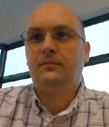
Prof. Dr.-Ing. Habil. Bogdan IONESCU
Coordinator of the Multimedia Lab, Center for Advanced Research on New Materials, Products and Innovative Processes, University "Politehnica" of Bucharest.
Coordinator of the Video Processing Group, The Image Processing and Analysis Lab, Faculty of Electronics, Telecommunications and Information Technology, University "Politehnica" of Bucharest.
Research interests: multimedia/video/image processing and analysis - multimedia content-based retrieval - machine learning for multimedia - multimedia benchmarking and evaluation - multimedia applications (e.g., video surveillance, lifelog, social media, medicine).
- Contact: bionescu at imag dot pub dot ro
- Website
- Google Scholar
- Research Gate
Violent Scenes Dataset
This dataset is intended to be used for assessing the quality of methods for the detection of violent scenes and/or the recognition of some high level, violent related, concepts in movies. It contains violence annotations for 32 Hollywood movies and 86 short web videos downloaded from YouTube.
The dataset was validated during the 2014 Affect in Multimedia Task: Violent Scenes Detection at the MediaEval Benchmarking Initiative for Multimedia Evaluation.
For more details see:
- M. Sjöberg, B. Ionescu, Y.-G. Jiang, V.L. Quang, M. Schedl and C.H. Demarty, “The MediaEval 2014 Affect Task: Violent Scenes Detection”, MediaEval Benchmarking Initiative for Multimedia Evaluation, vol. 1263, CEUR-WS.org, ISSN: 1613-0073, 2014 (task overview paper describing the dataset and the task - download PDF).
Download the dataset:
You can download the data from: http://www.technicolor.com/en/innovation/research-innovation/scientific-data-sharing/violent-scenes-dataset.
Acknowledgements:
We would like to thank the MediaEval benchmark and their organizers for their support in the creation of this dataset. We also would like to thank the different co-organizers during all these past years: Mohammad Soleymani and Guillaume Gravier, co-organizers of the Affect Task in 2011 and 2012, Yu-Gang Jiang, Vu Lam Quang, Bogdan Ionescu and Markus Schedl, co-organizers of the Affect Task in 2013 and 2014, who also participated in the definition of the violent segments; Mats Sjöberg who joined and led the organizers team in 2014.
The creation of this benchmark has also been supported, in part, by: Quaero Program, China’s National 973 Program #2010CB327900, China’s NSF Projects #61201387 and #61228205, VNU-HCM Project #B2013-26-01, Academy of Finland funding grants #255745 and #251170, UEFISCDI SCOUTER 28DPST/30-08-2013, Austrian Science Fund (FWF) P25655 and EU FP7-ICT-2011-9 #601166.
